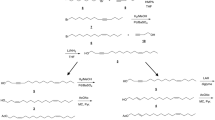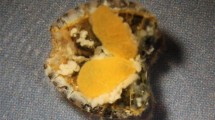Abstract
Three different types of traps were evaluated for a semiochemical-based trapping method for Hylotrupes bajulus (L.) (Cerambycidae). One, designated the ground trap, was the most efficient under both laboratory and natural conditions and had an active space of about 3.5 m. Significantly more beetles were captured in traps baited with a mixture of synthetic pheromones, (3R)-3-hydroxy-2-hexanone [(3R)-ketol] + 1-butanol, than in those with either single compound or with racemic mixtures. Furthermore, the synthetic lure captured more females than two virgin males in a laboratory bioassay. In addition, doubling the concentration of the synthetic pheromone significantly increased trap catches. The present findings have potential value of the management of this pest.

Similar content being viewed by others
References
J. D. Allison J. H. Borden S. J. Seybold (2004) ArticleTitleA review of the chemical ecology of the Cerambycidae (Coleoptera) Chemoecology 14 123–150 Occurrence Handle10.1007/s00049-004-0277-1
G. Becker (1944) ArticleTitleSinnesphysiologische Untersuchungen über die Eiablage des ausbockkäfers Z. Vgl. Physiol. 30 253–299 Occurrence Handle10.1007/BF00338590
K. F. Cannon W. H. Robinson (1982) ArticleTitleNotes on the biology and distribution of Hylotrupes bajulus (L.) (Coleoptera: Cerambycidae) in Virginia Entomol. News 93 173–176
H. Y. Fadamiro (1996) ArticleTitleInfluence of stimulus dose and wind speed on the orientation behaviour of Prostephanus truncatus (Coleoptera: Bostrichidae) to pheromone Bull. Entomol. Res. 86 659–665
R. Fettköther K. Dettner F. Schröder H. Meyer W. Francke U. Noldt (1995) ArticleTitleThe male pheromone of the old house borer Hylotrupes bajulus (L.) (Coleoptera: Cerambycidae): Identification and female response Experientia 51 270–277 Occurrence Handle10.1007/BF01931111
R. Fettköther G. V. P. Reddy U. Noldt K. Dettner (2000) ArticleTitleEffect of host and larvalfrass volatiles on behavioural response of the old house borer Hylotrupes bajulus (L.) (Coleoptera: Cerambycidae), in a wind tunnel bioassay Chemoecology 10 1–10 Occurrence Handle10.1007/s000490050001
M. Fukaya H. Honda (1996) ArticleTitleReproductive biology of the yellow-spotted longicorn beetle, Psacothea hilaris (Pascoe) (Coleoptera: Cerambycidae): V. Male mating responses to male extract Appl. Entomol. Zool. 31 95–98
R. M. Giblin-Davis J. E. Pena A. C. Oehlschlager A. L. Perez (1996) ArticleTitleOptimization of semiochemical-based trapping of Metamasius hemipterus sericeus (Oliver) (Coleoptera: Curculionidae) J. Chem. Ecol. 22 1389–1410 Occurrence Handle10.1007/BF02027720
R. H. Hallett A. L. Perez G. Gries R. Gries H. D. Pierce SuffixJr. J. Yue A. C. Oehlschlager L. M. Gonzalez J. H. Borden (1995) ArticleTitleAggregation pheromone of coconut rhinoceros beetle, Oryctes rhinoceros (L.) (Coleoptera: Scarabaeidae) J. Chem. Ecol. 21 1549–1570 Occurrence Handle10.1007/BF02035152
L. M. Hanks (1999) ArticleTitleInfluence of the larval host plant on reproductive strategies of cerambycid beetles Annu. Rev. Entomol. 44 483–505 Occurrence Handle10.1146/annurev.ento.44.1.483 Occurrence Handle15012380
K. Iwabuchi J. Takahashi Y. Nakagawa T. Sakai (1986) ArticleTitleBehavioral responses of female grape borer Xylotrechus pyrrhoderus BATES (Coleoptera: Cerambycidae) to synthetic male sex pheromone components Appl. Entomol. Zool. 21 21–27
J. T. Mares W. H. Robinson (1985) ArticleTitleThe old house borer and wood damage go hand-in hand Pest Control 53 31–32
D. R. Miller K. E. Gibson K. F. Raffa S. J. Seybold S. A. Teale D. L. Wood (1997) ArticleTitleGeographic variation in response of pine engraver, Ips pini, and associated species to pheromone, lanierone J. Chem. Ecol. 23 2013–2031 Occurrence Handle10.1023/B:JOEC.0000006486.39056.48
A.-M. Nerg J. Heijari U. Noldt H. Viitanen M. Vuorinen P. Kainulainen J. K. Holopainen (2004) ArticleTitleSignificance of wood terpenoids in the resistance of Scots pine provenances against the old house borer, Hylotrupes bajulus, and brown-rot fungus, Coniophora puteana J. Chem. Ecol. 30 125–141 Occurrence Handle10.1023/B:JOEC.0000013186.75496.68 Occurrence Handle15074661
U. Noldt R. Fettköther K. Dettner (1995) ArticleTitleStructure of the sex pheromone-producing prothoracic glands of the male old house borer, Hylotrupes bajulus (L.) (Coleoptera: Cerambycidae) Int. J. Insect Morphol. Embryol. 24 223–234 Occurrence Handle10.1016/0020-7322(95)93345-D
F. Schröder R. Fettköther U. Noldt K. Dettner W. A. König W. Francke (1994) ArticleTitleSynthesis of (3R)-3-hydroxy-2-hexanone, (2R, 3R)-2, 3-hexanediol and (2S, 3R)-2, 3-hexanediol, the male sex pheromone of Hylotrupes bajulus and Pyrrhidium sanguineum (Cerambycidae) Liebigs Ann. Chem. 12 1211–1218
R. R. Sokal F. J. Rohlf (1995) Biometry: The Principles and Practices of Statistics in Biological Research Freeman and Company New York
D. M. Suckling A. R. Gibb G. M. Burnip C. Snelling J. Ruiter Particlede G. Langford A. M. El-Sayed (2005) ArticleTitleOptimization of pheromone lure and trap characteristics for currant clearwing, Synanthedon tipuliformis J. Chem. Ecol. 31 393–406 Occurrence Handle10.1007/s10886-005-1348-7 Occurrence Handle15856791
M. G. White (1954) ArticleTitleThe house longhorn beetle Hylotrupes bajulus L. (Col. Cerambycidae) in Great Britain Forestry 27 31–40
Acknowledgments
We thank Drs. Frank Schröder and Wittko Francke for providing the synthetic pheromone compound and Ms. Dorothea Martin Klöckner for technical assistance in rearing of beetles. We are grateful to the German Federal Foundation for the Environment (Deutsche Bundesstiftung Umwelt, Osnabrück) for financial support of the project. We thank Ms. Mary Finlay-Doney, University of Queensland (Australia), for helpful comments on earlier versions of the manuscript. Finally, we thank the Alexander von Humboldt Foundation, Bonn, for the Humboldt Research fellowship to the senior author. We also thank two anonymous reviewers and Dr. Jeremy N. McNeil for their valuable comments.
Author information
Authors and Affiliations
Corresponding author
Rights and permissions
About this article
Cite this article
Reddy, G.V.P., Fettköther, R., Noldt, U. et al. Capture of Female Hylotrupes bajulus as Influenced by Trap Type and Pheromone Blend. J Chem Ecol 31, 2169–2177 (2005). https://doi.org/10.1007/s10886-005-6083-6
Received:
Revised:
Accepted:
Published:
Issue Date:
DOI: https://doi.org/10.1007/s10886-005-6083-6




